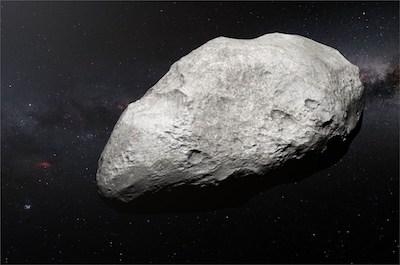Space Rock Is More Than 2.5 Billion Miles From Earth
An international team of astronomers has used ESO telescopes to investigate a relic of the primordial Solar System. The team found that the unusual Kuiper Belt Object 2004 EW95 is a carbon-rich asteroid, the first of its kind to be confirmed in the cold outer reaches of the Solar System. This curious object likely formed in the asteroid belt between Mars and Jupiter and has been flung billions of kilometres from its origin to its current home in the Kuiper Belt.

The early days of our Solar System were a tempestuous time. Theoretical models of this period predict that after the gas giants formed they rampaged through the Solar System, ejecting small rocky bodies from the inner Solar System to far-flung orbits at great distances from the Sun. In particular, these models suggest that the Kuiper Belt — a cold region beyond the orbit of Neptune — should contain a small fraction of rocky bodies from the inner Solar System, such as carbon-rich asteroids, referred to as carbonaceous asteroids.
Now, a recent paper has presented evidence for the first reliably-observed carbonaceous asteroid in the Kuiper Belt, providing strong support for these theoretical models of our Solar System’s troubled youth. After painstaking measurements from multiple instruments at ESO’s Very Large Telescope (VLT), a small team of astronomers led by Tom Seccull of Queen’s University Belfast in the UK was able to measure the composition of the anomalous Kuiper Belt Object 2004 EW95, and thus determine that it is a carbonaceous asteroid. This suggests that it originally formed in the inner Solar System and must have since migrated outwards.
The peculiar nature of 2004 EW95 first came to light during routine observations with the NASA/ESA Hubble Space Telescope by Wesley Fraser, an astronomer from Queen’s University Belfast who was also a member of the team behind this discovery. The asteroid’s reflectance spectrum — the specific pattern of wavelengths of light reflected from an object — was different to that of similar small Kuiper Belt Objects (KBOs), which typically have uninteresting, featureless spectra that reveal little information about their composition.
“The reflectance spectrum of 2004 EW95 was clearly distinct from the other observed outer Solar System objects,” explains lead author Seccull. “It looked enough of a weirdo for us to take a closer look.”
The team observed 2004 EW95 with the X-Shooter and FORS2 instruments on the VLT. The sensitivity of these spectrographs allowed the team to obtain more detailed measurements of the pattern of light reflected from the asteroid and thus infer its composition.
However, even with the impressive light-collecting power of the VLT, 2004 EW95 was still difficult to observe. Though the object is 186 miles across, it is currently a colossal 2.5 billion miles from Earth, making gathering data from its dark, carbon-rich surface a demanding scientific challenge.
“It’s like observing a giant mountain of coal against the pitch-black canvas of the night sky,” says co-author Thomas Puzia from the Pontificia Universidad Católica de Chile. “Not only is 2004 EW95 moving, it’s also very faint. We had to use a pretty advanced data processing technique to get as much out of the data as possible.”
Two features of the object’s spectra were particularly eye-catching and corresponded to the presence of ferric oxides and phyllosilicates. The presence of these materials had never before been confirmed in a KBO, and they strongly suggest that 2004 EW95 formed in the inner Solar System.
"Given 2004 EW95’s present-day abode in the icy outer reaches of the Solar System, this implies that it has been flung out into its present orbit by a migratory planet in the early days of the Solar System,” Seccull said. “While there have been previous reports of other ‘atypical’ Kuiper Belt Object spectra, none were confirmed to this level of quality,” comments Olivier Hainaut, an ESO astronomer who was not part of the team. “The discovery of a carbonaceous asteroid in the Kuiper Belt is a key verification of one of the fundamental predictions of dynamical models of the early Solar System.”
(Image provided with European Southern Observatory news release)
 Airborne 11.05.25: Tesla Flying Car?, Jepp/ForeFlight Sold, A220 Troubles
Airborne 11.05.25: Tesla Flying Car?, Jepp/ForeFlight Sold, A220 Troubles Airborne 11.07.25: Affordable Expo Starts!, Duffy Worries, Isaacman!
Airborne 11.07.25: Affordable Expo Starts!, Duffy Worries, Isaacman! Aero-News: Quote of the Day (11.05.25)
Aero-News: Quote of the Day (11.05.25) ANN's Daily Aero-Linx (11.05.25)
ANN's Daily Aero-Linx (11.05.25) NTSB Prelim: Cirrus Design Corp SR22
NTSB Prelim: Cirrus Design Corp SR22



